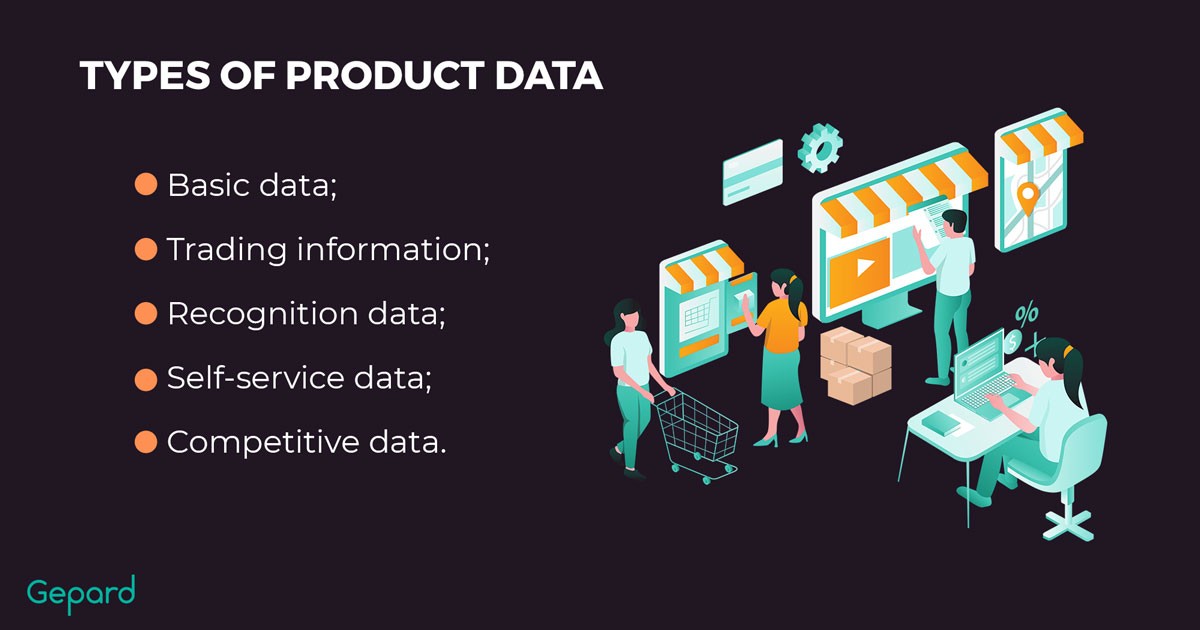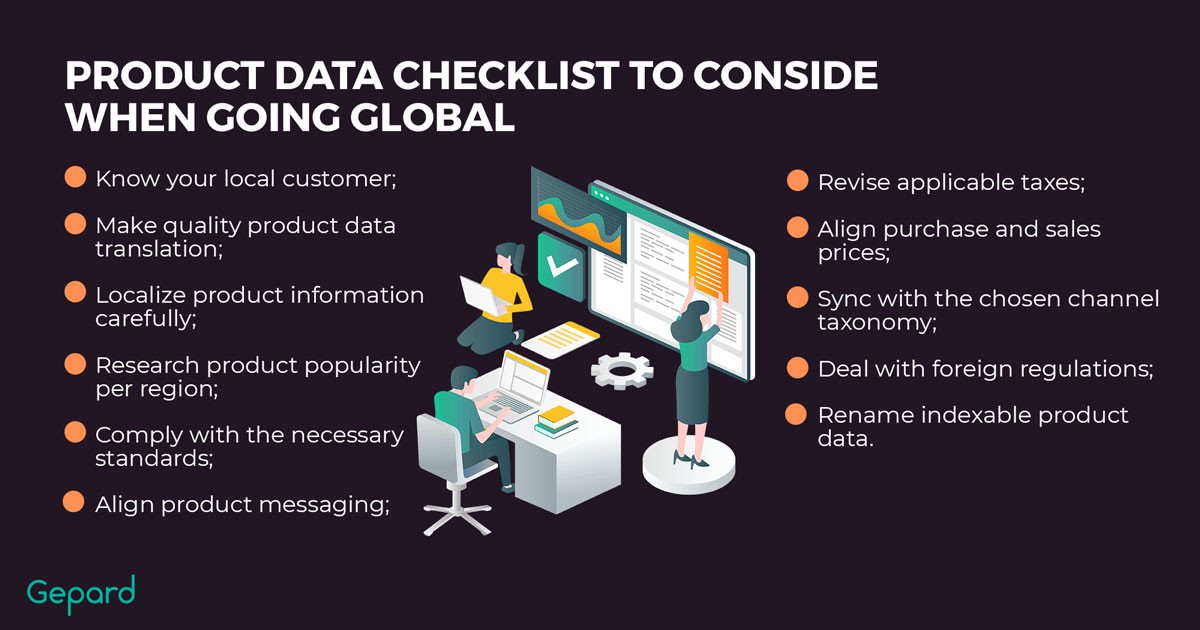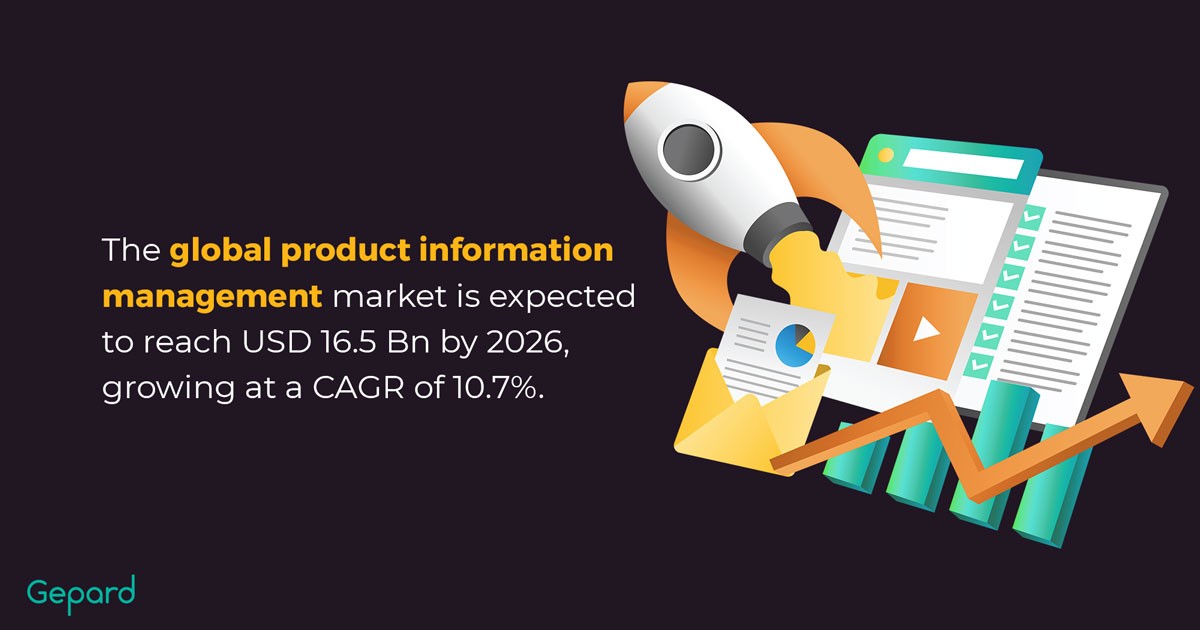The Go-Global Checklist For Your Product Information
High-quality product information positions your brand for success when expanding to international markets. It has to adapt to the language of your new target audience, including all elements that facilitate product discovery and sales.
In this article, we’ll explain what product information is, its types, a definitive product data checklist for going global, and the relevance of PIM in your go-global checklist.
What Is Product Information?
Types Of Product Data
1. Basic Information
This data applies to all relevant information that discloses the name, characteristics, and benefits of a specific commodity. Examples are:
- Product Identification Data
It entails information such as the product name, SKU, and unique identifiers.
- Short Description
Descriptions convey details about the features and benefits of a commodity. It may also include SEO keywords and elements that improve the visibility of a product.
- Supplier Data
It includes all relevant information that applies to goods and services from suppliers. Examples are supplier’s name, stock data, product categories, procurement history, etc.
- Material Type
A material type is a category of finished or semi-finished products, spare parts, or other resources that have similar attributes.
2. Trading Data
Trading data covers all unique product identifiers that simplify the tracking, discovery, and checkout process of each item in a database. It includes:
- GTIN/ MPN/ASIN
These identifiers ease inventory tracking and simplify product information exchange between manufacturers and retailers. They also help customers to find the right item faster in relevant searches.
- Commodity Codes
This eCommerce product data comprises barcodes, RFID codes, product keys, or serial numbers that help to identify trade items and their features. These identifiers are mainly used to scan goods at the point of sale.

3. Recognition Data
This entails text and media assets that visually distinguish a product. Examples of recognition data are:
This covers engaging copy, high-resolution media, catalog, and similar content that gives a shopper more information about an item.
- Product Images
This includes all pictures that visually represent the physical attributes of an item.
- Product Videos
Videos bring your product to life. They showcase how your item works and its tangible benefits.
- 360 Degrees Galleries
These galleries aim to provide an immersive experience to users, showing them different sides of a specific product.
4. Self-Service Information
Self-service data guides customers in using a specific item. It includes:
- Product Attributes
Product attributes data comprises tangible and intangible properties of an item. They assist customers in discovering, comparing, and selecting a product.
- Product Relations
This data defines the nature of the relationship between products. It is useful for automated product recommendations.
- Varied Digital Assets
Another type of self-service data is varied digital assets such as product guides, schemes, and manuals that guide buyers when purchasing and using a product.
5. Competitive Product Data
This eCommerce product data highlights details of related products. Examples are:
- Long Product Descriptions
This data provides in-depth information on the properties, benefits, and all other elements a buyer needs to make an informed buying decision.
- Cross-sell /Up-sell Data
Cross-sell and up-sell data highlights alternative and complementary products that deliver a highly relevant experience to shoppers.
- Product Taxonomy
Product taxonomy data comprises product categories and attributes that facilitate easy navigation and item search.
- Pricing Information
As the name implies, this data provides the prices of products in a specific currency.
Product Data Checklist To Consider When Going Global
Expanding to global markets is a reliable growth tactic for many businesses. It opens up a brand to a larger target audience, increased visibility, and more sales.
However, it also comes with some challenges, such as managing massive amounts of product data. This factor increases the chances of omitting critical product data and failing to meet compliance standards in the new target market. With that in mind, we’ve created this simple checklist to help you along.
1. Know Your Local Customer
A successful global expansion requires understanding your local customers. Start by defining the buyer persona and their journey. Who is your target audience? How do they buy, what do they expect of you, and what do they think of your competitors? This information will give you insight into their demographics, preferences, language specifics, and cultural sensitivities.
2. Make Quality Product Data Translation
Next, create product information for your goods and services in one common language. And then translate to other languages for your global audience. Keep in mind that a poor translation would not only confuse your audience but may damage your brand’s reputation. As such, if you choose translation software, consider hiring a professional human translator to review the quality of work.
3. Localize Product Information Carefully
Content localization goes further than translation. It requires adapting existing product information to your new target audiences for cultural and contextual relevance. It also considers subtle variations of a common language. For instance, product data for eCommerce in the UK may say “Jumper”, while a common variation in the US is “Sweater”. Other localization elements include:
- Product dimension (size and units);
- Currencies (Dollar, pounds, euros, etc.);
- Location terms (Best office desks in “Chicago”);
- Region-based product identifiers (UPC, EAN, JAN, etc.)

4. Research Product Popularity Per Region
As mentioned earlier, the needs of your customers may vary across regions. Identifying product trends helps you serve the right goods and services in optimal quantities to each market. You could use data exploration tools like Google Trends to view seasonal trends in each region, monitor competitors’ positions, or even find relevant product categories.
5. Comply Product Specifications With the Necessary Standards
After trends research, it’s time to outline the specifications of your goods. Specs may include the components, dimensions, volume, packaging information, testing requirements, etc. Find out which standards apply to you and meet them. Failure to comply may attract fines or cause delayed business processes. An example of a well-known standard is the ISO 9000, which supports the accessibility of accurate, reliable product data by external partners.
6. Align Product Messaging
The purpose of your product messaging is to communicate your product’s internal value to prospects. First off, invest in an SEO-friendly copy that highlights the compelling benefits the product offers. Include high-quality media such as images and videos to boost engagement. And finally, provide self-serve information that allows them to resolve challenges by themselves. These could be user guides and well-detailed product information cards.
7. Revise Applicable Taxes
As applicable taxes vary drastically across countries, so may pricing. As a result, clarifying your responsibilities helps ensure you’re on the right track. Consider implementing targeted strategies like the global transfer pricing rules to ensure compliance and less tax burden. Also, update your product pricing data using free VAT calculator to accurately reflect the VAT or sales tax in each region.
8. Sync With the Chosen Channel Taxonomy
Product taxonomy deals with item relations and their organization into categories and sub-categories. There are many industry standards for organizing your items. However, each eCommerce sales channel may have specific practices to improve product discovery in each region. Examples are classifications that reflect:
- Seasonality (e.g., ‘winter wears’ in cold regions Vs. regular ‘collections’ in the tropics );
- Location-specific terms (biscuit Vs. cookies);
- Religion or cultural-based classification (for example, shorts may be removed under ‘women’s wear’ in Muslim-majority countries).
9. Deal With Foreign Regulations
What local laws and rules apply to your products? Some of these regulations may affect the product information you disclose. Labeling requirements, for instance, may differ. While most countries require full disclosure on ingredients or materials used in the product, others may require you to use specific local languages. Also, certain consumer products have strict regulations. Do your due diligence and meet the requirements.
10. Rename Indexable Product Data
Finally, localize all your product information online. This helps customers across countries and languages find what they’re looking for easily. Aside from product name, dimensions, and identifiers we mentioned earlier, you can localize other elements such as:
- Product images, titles, and alt descriptions;
- Meta tags and titles;
- Payment preferences;
- Videos and other multimedia;
- Product documentation;
- URLs (domin.com.uk).
Make a Product Information Management System Your Single Source Of Truth
The surge in eCommerce transactions has spurred the need to manage large product data volumes. This increasing need is particularly visible in the global PIM market projected to grow at a CAGR of 10.7% from $9.9 Bn in 2021 to $16.5 Bn by 2026. By centralizing information in a product data management solution, businesses can automate data-related tasks, eliminate data inconsistencies, and increase speed-to-market. That said, let’s explore how to make product data management software your single source of truth.

-
Organize Multitenant Access To Product Data
Accessing accurate product information is critical, especially in organizations with several teams, suppliers, and other market players spread across locations. But how do you control who sees what? That’s where multi-tenant access comes in. Product data management solutions like Gepard allow you to assign different access levels to multiple users. With this, each user quickly gets up-to-date product information that’s limited to their roles.
-
Centralize And Standardize Quality Product Information
A reliable PIM tool with advanced content management functionality allows you to transform, organize, and enrich goods information. Usually, every region and sales channel has its data standards. If you’re practicing an omnichannel approach, this means adapting your data to the rigorous demands of each platform. A product data management system simplifies the process. At the same time, you can also use data validation tools to spot errors and improve data quality across these channels.
-
Deliver Rich Content Localization At Scale
Adapting product data to the needs of your new local customers improves product discovery and, in turn, sales. However, you’ll lose precious time (and quality) doing it one at a time. Instead, use a PIM tool to push your product information to multiple marketplaces seamlessly. Check previous sections to understand common elements to localize in your content.
Product Information FAQ
Which product data should I consider changing when going global?
Product data to consider when going global include the item’s name, descriptions, unique product identifiers, media assets, user guides, and product documentation. Pay attention to competitive data such as cross-selling/up-selling information, as well.
How to start product information localization?
Kick-off your eCommerce localization strategy by studying your local customers and competitors. With this data-driven product management approach, you’ll get a better idea of the elements to localize. Also, use PIM solutions to automate product data exchange, improve content quality, and save lots of time.
How to enrich my product data?
Create unique descriptions, import images, and check for errors to enrich your product data. Ensure that all information on your product information sheet or pages is clear, accurate, and consistent.
Go Global With Gepard PIM
The staggering data volume involved in going global leaves no doubt that PIM is a must for brands, manufacturers, retailers, and other market players. For one, the tedious tasks could slow you down significantly. It could also take up too much of your resources.
With Gepard, you can automate product data delivery, ensure consistency, and pursue your expansion goals confidently. It is especially relevant for brands that sell many items and have to syndicate and deliver product information to several sales channels rapidly.
Ready to dominate international markets with high-quality product data? Book a personalized demo now.





